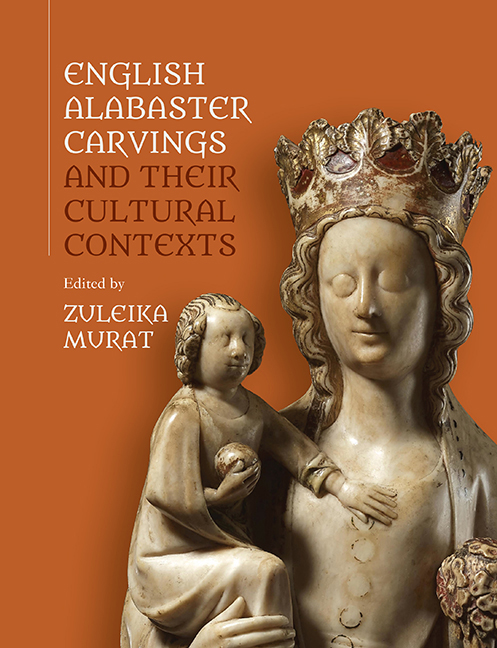Book contents
- Frontmatter
- CONTENTS
- List of Illustrations
- Acknowledgements
- List of Contributors
- Introduction
- 1 ‘Burton-Upon-Trent, Not Nottingham.’ the Evolving Study Of Medieval English Alabaster Sculpture
- 2 Stone to Ensure Victory and to Generate Friendships. On The Meaning of Alabaster
- 3 Contextualising English Alabasters in the Material Culture of the Medieval Mediterranean
- 4 English Alabaster Images As Recipients of Music in the Long Fifteenth Century: English Sacred Traditions in a European Perspective
- 5 Contextualising Alabasters in Their Immersive Environment. The ‘Ancona D'Allabastro Di Diverse Figure’ of the Novalesa Abbey: Meaning and Function
- 6 Alabaster Carvings in Late-Medieval Lincolnshire
- 7 ‘Tabernacles, Howsynges and Other Things’. Three Alabasters From the Burrell Collection in Context
- 8 Conservation Study of Three Alabaster Carvings From the Burrell Collection, Glasgow Museums
- 9 ‘Smooth as Monumental Alabaster’. the Alabaster Tomb Industry in England 1550–1660
- 10 Merchants’ Tombs in Alabaster
- 11 Exploring Alice: the Theological, Socio-Historical, and Anatomical Context of the De La Pole Cadaver Sculpture
- Bibliography
- Index
- Already Published
8 - Conservation Study of Three Alabaster Carvings From the Burrell Collection, Glasgow Museums
Published online by Cambridge University Press: 14 September 2019
- Frontmatter
- CONTENTS
- List of Illustrations
- Acknowledgements
- List of Contributors
- Introduction
- 1 ‘Burton-Upon-Trent, Not Nottingham.’ the Evolving Study Of Medieval English Alabaster Sculpture
- 2 Stone to Ensure Victory and to Generate Friendships. On The Meaning of Alabaster
- 3 Contextualising English Alabasters in the Material Culture of the Medieval Mediterranean
- 4 English Alabaster Images As Recipients of Music in the Long Fifteenth Century: English Sacred Traditions in a European Perspective
- 5 Contextualising Alabasters in Their Immersive Environment. The ‘Ancona D'Allabastro Di Diverse Figure’ of the Novalesa Abbey: Meaning and Function
- 6 Alabaster Carvings in Late-Medieval Lincolnshire
- 7 ‘Tabernacles, Howsynges and Other Things’. Three Alabasters From the Burrell Collection in Context
- 8 Conservation Study of Three Alabaster Carvings From the Burrell Collection, Glasgow Museums
- 9 ‘Smooth as Monumental Alabaster’. the Alabaster Tomb Industry in England 1550–1660
- 10 Merchants’ Tombs in Alabaster
- 11 Exploring Alice: the Theological, Socio-Historical, and Anatomical Context of the De La Pole Cadaver Sculpture
- Bibliography
- Index
- Already Published
Summary
This contribution presents conservation observations obtained from technical and material investigation of three fifteenth-century alabaster carvings, depicting the head of St John the Baptist in wooden and polychromed cases. The study was initiated in contribution to the art historical research into these alabasters from the Burrell Collection, Glasgow Museums accession numbers: 1.33 (Pl. XI), 1.34 (Pl. X), 1.35 (Pl. XII).
Individual objects were examined visually under visible and ultra violet lighting to investigate and record materials, structure, tool marks and construction techniques. This was done prior to microscopic investigation by stereo microscope to identify and record evidence of physical, biological and chemical degradation as part of the overall conservation condition assessment.
Analytical investigation through scientific elemental analysis of pigments was carried out to provide initial indicators that may serve further comparative study of similarities and differences in the source and use of paint, polychromy and iconography.
Results and observations from this study are presented and assessed within the initial conservation condition description.
1.33
DESCRIPTION
The piece consists of one carved alabaster component, depicting the Head of St John the Baptist in the centre of the carved relief. To the left and right are figures, and a Man of Sorrows is depicted below the head. The surfaces display evidence for polychromy and gilding.
It was not possible to remove the alabaster from the case, as the attachment points were hidden behind the narrow plank attached to the back.
The carving is set inside a wooden box with wings to the left and right allowing the image to be hidden and/or revealed. The mechanism for opening and closing consists of metal wires which hold the separate wings in place through perforated holes.
The outside faces of the wooden wings are of plain homogenous colouration, while the inside surfaces show evidence of polychromy.
The base is constructed of two pieces which are joined together with a single nail. An ‘X’ is marked into the wood at the bottom. A horizontal piece with angled sections of wood held in place with 3 nails, comprises the frame.
A paper label, visible on the left wing panel when closed, records the rediscovery of this object from beneath floor boards of a house adjoining the ‘New Bank Buildings’, citing the Ipswich Journal 1789.
- Type
- Chapter
- Information
- English Alabaster Carvings and their Cultural Contexts , pp. 194 - 213Publisher: Boydell & BrewerPrint publication year: 2019



